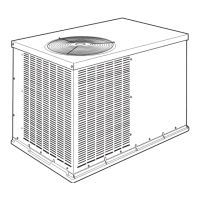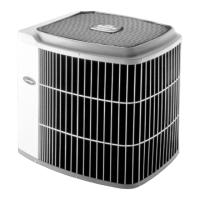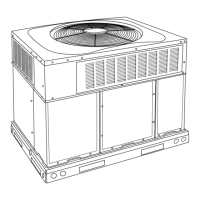2
513 01 3103 00
SAFETY CONSIDERATIONS
Installation and servicing of this equipment can be hazardous due
to mechanical and electrical components. Only trained and
qualified personnel should install, repair, or service this
equipment.
Untrained personnel can perform basic maintenance functions
such as cleaning and replacing air filters. All other operations
must be performed by trained service personnel. When working
on this equipment, observe precautions in the literature, on tags,
and on labels attached to or shipped with the unit and other safety
precautions that may apply.
Follow all safety codes. Installation must be in compliance with
local and national building codes. Wear safety glasses, protective
clothing, and work gloves. Have fire extinguisher available. Read
these instructions thoroughly and follow all warnings or cautions
included in literature and attached to the unit.
Recognize safety information. This is the safety --alert symbol
.
When you see this symbol on the unit and in instructions or
manuals, be alert to the potential for personal injury. Understand
these signal words: DANGER, WARNING, and CAUTION. These
words are used with the safety--alert symbol. DANGER identifies
the most s erious hazards which will result in severe personal
injury or death. WARNING signifies hazards which could result in
personal injury or death. CAUTION is used to identify unsafe
practices which may result in minor personal injury or product and
property damage. NOTE is used to highlight suggestions which
will result in enhanced installation, reliability, or operation.
ELECTRICAL SHOCK HAZARD
Failure to follow this warning could result in personal injury or
death.
Before installing or servicing system, always turn off main
power to system and install lockout tag. There may be more
than one disconnect switch. Turn off accessory heater power
switch if applicable.
!
WARNING
PERSONAL INJURY AND ENVIRONMENTAL HAZARD
Failure to relieve system pressure could result in personal injury
and/or death.
1. Relieve pressure and recover all refrigerant before servicing
existing equipment, and before final unit disposal. Use all
service ports and open all flow--control devices, including
solenoid valves.
2. Federal regulations require that you do not vent refrigerant
into the atmosphere. Recover during system repair or final unit
disposal.
WARNING
!
CUT HAZARD
Failure to follow this caution may result in personal injury.
When removing access panels or performing maintenance
functions inside your unit, be aware of sharp sheet metal parts
and screws. Although special care is taken to reduce sharp
edges to a minimum, be extremely careful when handling parts
or reaching into the unit.
CAUTION
!
FIG. 1 -- UNIT PAD3
INTRODUCTION
The PAD3 units are fully self--contained and designed for outdoor
installation. (See Fig. 1.) All unit sizes have discharge openings
for both horizontal and downflow configurations, and are factory
shipped with all downflow duct openings covered. The unit may
be installed either on a rooftop or on a ground --level cement slab.
(See Fig. 6 for roof curb dimensions.)
RECEIVING AND INSTALLATION
Step 1 — Check Equipment
Identify Unit
The unit model number and serial number are stamped on the
unit identification plate. Check this information against shipping
papers.
Inspect Shipment
Inspect for shipping damage before removing packaging
materials. If unit appears to be damaged or is torn loose from its
anchorage, have it examined by transportation inspectors before
removal. Forward claim papers directly to transportation company.
Manufacturer is not responsible for any damage incurred in
transit. Check all items against shipping list. Immediately notify the
nearest equipment distributor if any item is missing. To prevent
loss or damage, leave all parts in original packages until
installation.
Step 2 — Provide Unit Support
IMPORTANT: The unit must be secured to the curb by installing
screws through the bottom of the curb flange and into the unit
base rails. When installing large base units onto the common
curb, the screws must be installed before allowing the full weight
of the unit to rest on the curb. A minimum of six screws are
required for large base units. Failure to secure unit properly could
result in an unstable unit. See Warning near Rigging/Lifting
information and accessory curb instructions for more details.
For hurricane tie downs, contact distributor for details and PE
(Professional Engineering) Certificate if required.
Roof Curb
Install accessory roof curb in accordance with instructions
shipped with curb (See Fig. 6). Install insulation, cant strips,
roofing, and flashing. Ductwork must be attached to curb.

